Camponotus (Myrmosericus) rufoglaucus (Jerdon) -
Africa forms
 Main
species page Type locality India
(Formica
Rufo-glauca, Jerdon, 1851: 124, worker) Carnatic Main
species page Type locality India
(Formica
Rufo-glauca, Jerdon, 1851: 124, worker) Carnatic
Africa form
(subspecies)
latericius (Camponotus
(Myrmosericus) rufoglaucus
Jerd. r. latericius n.
stirps, Stitz, 1923: 165, minor worker) Namibia, Neitas Farm
- see below
syphax (Camponotus
(Myrmosericus) rufoglaucus subspecies syphax new subspecies, Wheeler,
1922: 246, minor & major workers, see below) Zaïre - see
below
zulu (Camponotus
(Myrmosericus) rufoglaucus
Jerd. sou-esp. zulu n.
subsp., Emery, 1895h: 50, minor & major workers) South Africa,
Natal, M Weitzecker - see below
unavailable names
chaboti (Camponotus
(Myrmosericus) rufoglaucus Jerd. st. controversus Sants., var. chaboti n. var., Santschi, 1925h:
167, minor & major workers & queen) from Angola - see
below
miniata (Camponotus
rufoglaucus Jerd. race flavo-marginata
Mayr, var. miniata n. var.,
Arnold, 1947:
136, workers) from Zambia - see below
vertex (C. (Myrmosericus) rufoglaucus Jerdon
stirps cinctellus
Gerst. v. vertex n. v., Santschi, 1935a: 280, worker &
queen) Zaïre
collected at Luluaborg, 26.i.1912, by P. Callewaert - see below
minor & major workers & queen described (see Bolton, 1995) 
For the present I have separated zanzibaricus (Camponotus
rufoglaucus Jerd. subsp. zanzibaricus
n. sbsp., Forel, 1911e: 287, minor worker) Zanzibar; as
differing so greatly as to appear to be a separate species - see below.
|
Emery (1895h) had subspecies zulu as larger than
type, tibiae flatter almost as eugeniae but scapes less
compressed than latter; pubescence golden; TL major 9-9.5 mm; minor TL
7 mm. His descriptions and a key to the forms from India, the
circum-Mediterranean area and Africa is at  . His description of zulu is
extracted at . His description of zulu is
extracted at  . .
Forel's (1911e)
description of zanzibaricus is at  . Viehmeyer's (1914c)
description of flavopilosus is at . Viehmeyer's (1914c)
description of flavopilosus is at  . Santschi's (1916b)
naming of controversus is at . Santschi's (1916b)
naming of controversus is at  . Stitz's (1923)
description of latericius is at . Stitz's (1923)
description of latericius is at  . Santschi's (1925h)
description of chaboti is at . Santschi's (1925h)
description of chaboti is at  .
Santschi's (1935a)
description of vertex is at .
Santschi's (1935a)
description of vertex is at  .
Arnold's (1947)
description of miniata is at .
Arnold's (1947)
description of miniata is at  . .
|
African dark forms
(note: the apparently exaggerated magenta tint of all Antweb images
hinders colour separations, so this is tentative on my part)
|
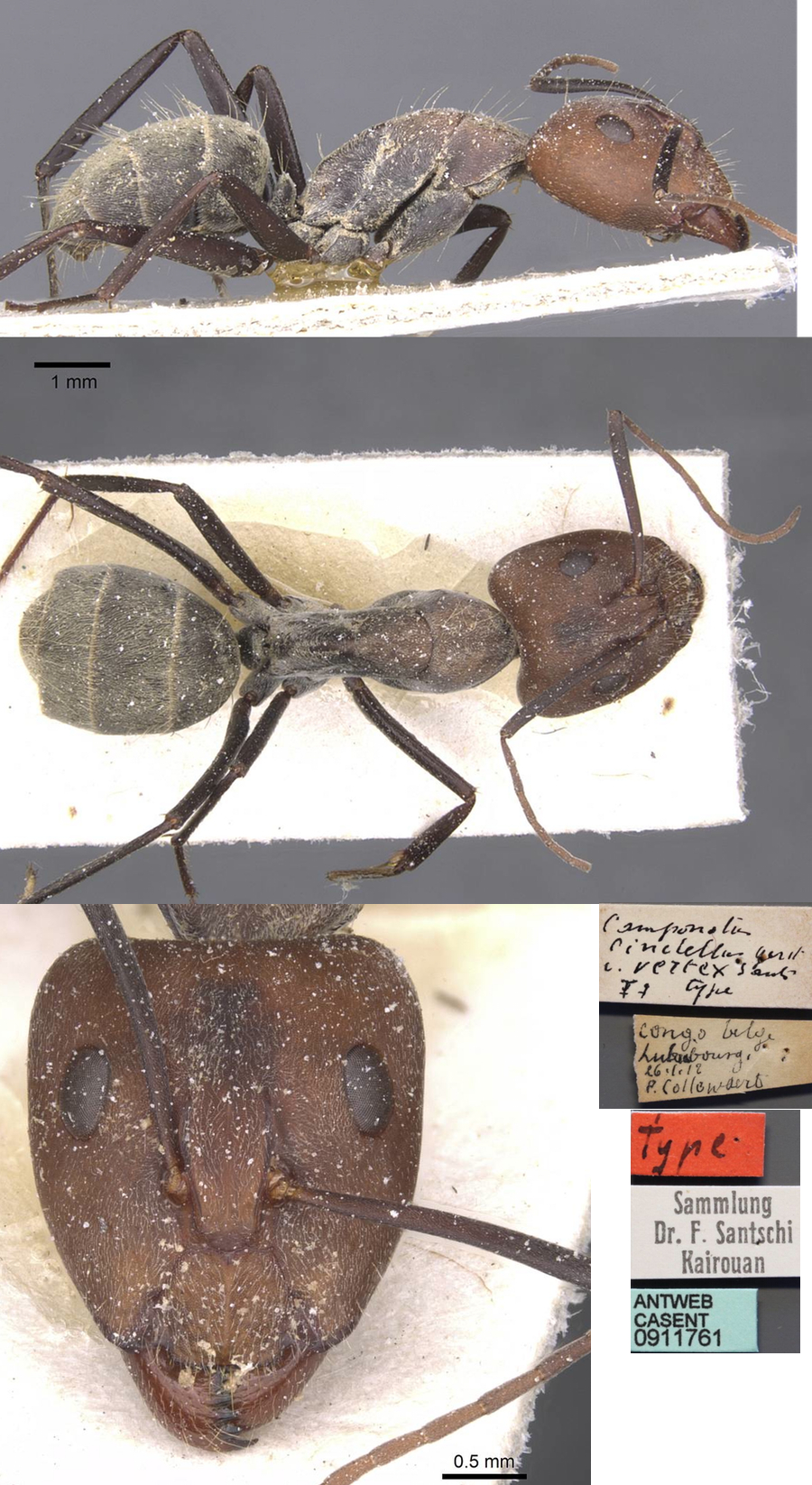 The
photomontage of
a major worker of vertex is collated from http://www.antweb.org/specimen.do?name=casent0911761. The
photomontage of
a major worker of vertex is collated from http://www.antweb.org/specimen.do?name=casent0911761.
|
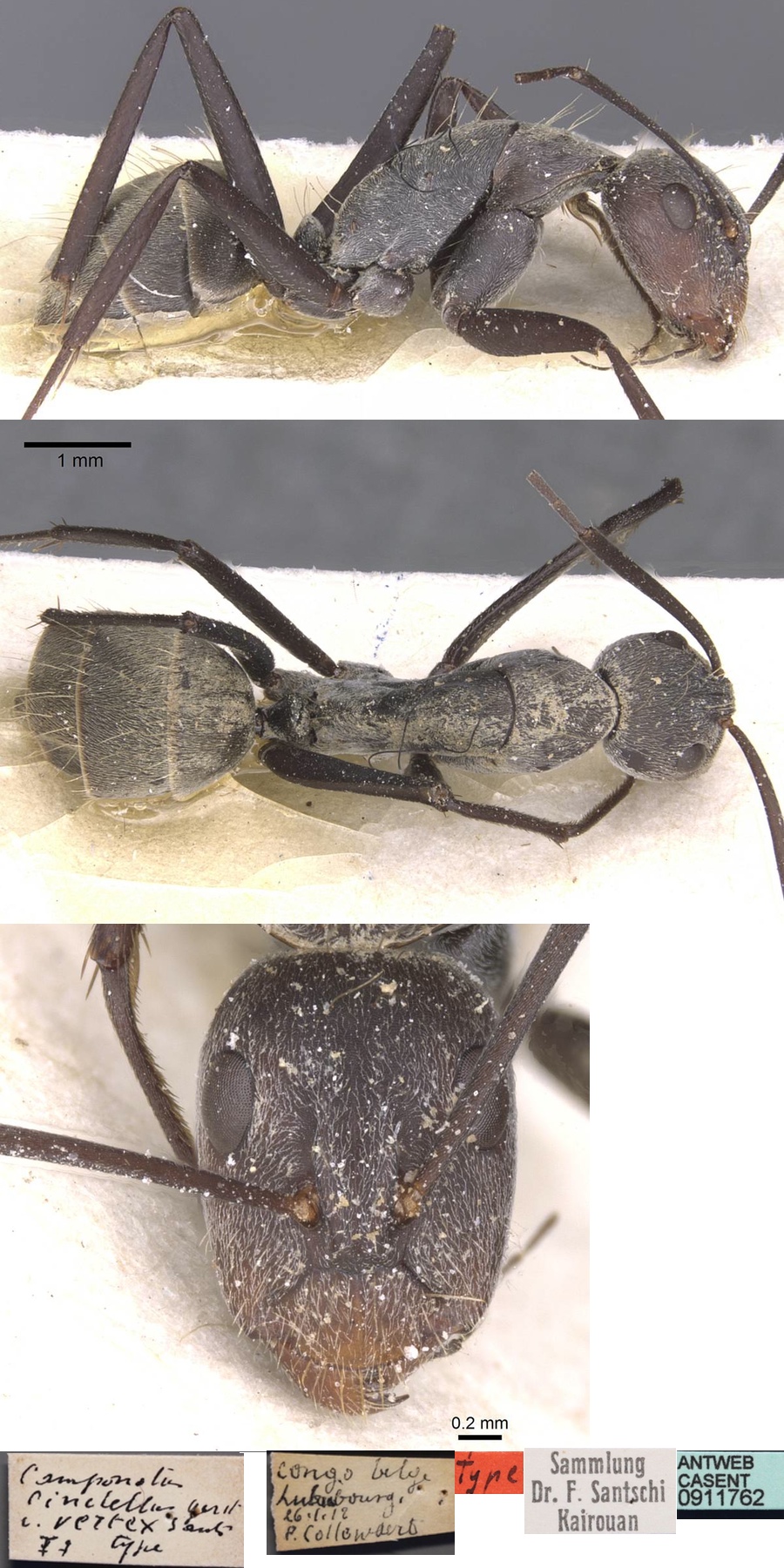 The
photomontage of
a minor worker of vertex is
collated from http://www.antweb.org/specimen.do?name=casent0911762. The
photomontage of
a minor worker of vertex is
collated from http://www.antweb.org/specimen.do?name=casent0911762.
|
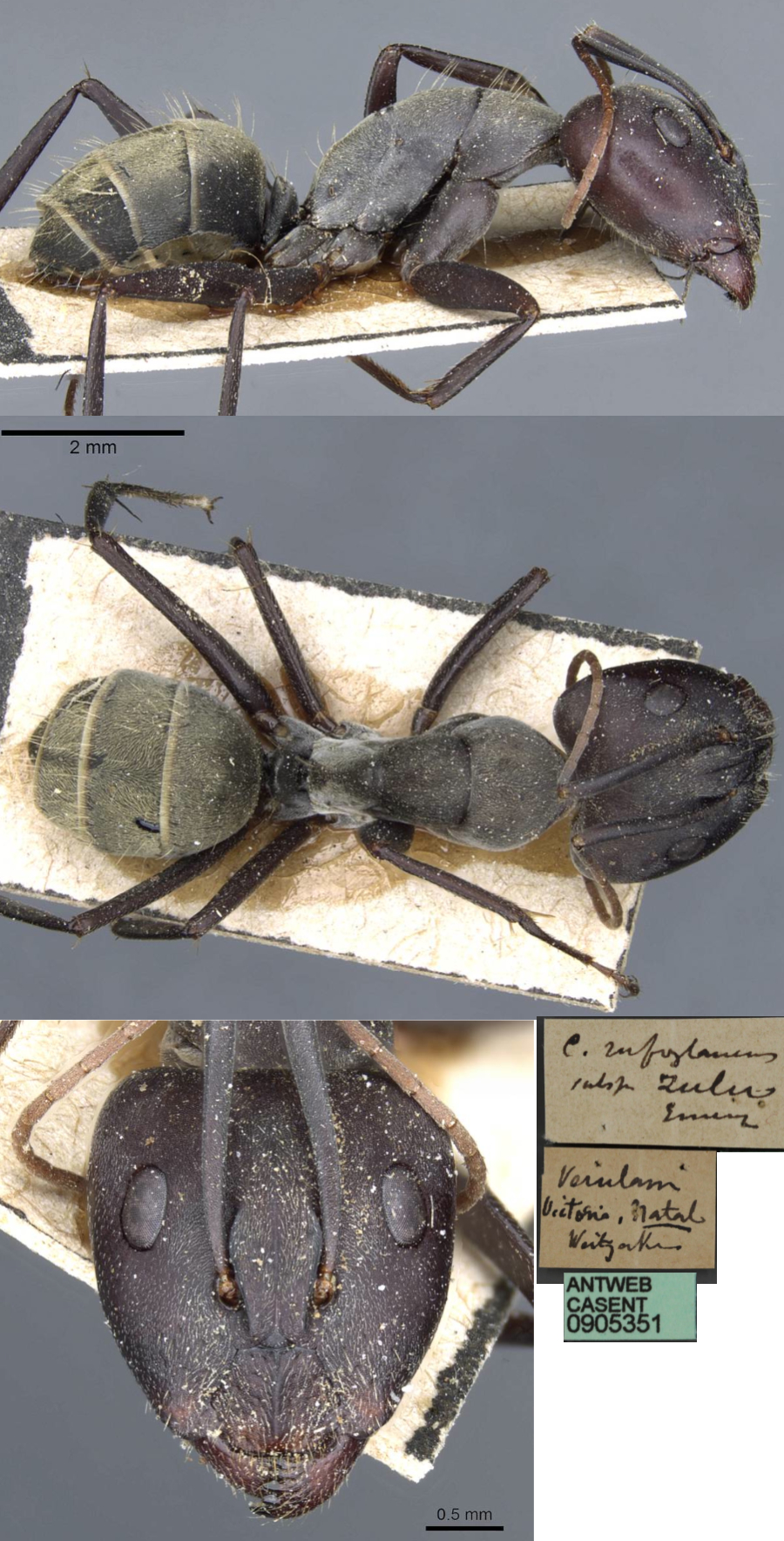 The
photomontage of
a major worker of zulu is collated from http://www.antweb.org/specimen.do?name=casent0905351. The
photomontage of
a major worker of zulu is collated from http://www.antweb.org/specimen.do?name=casent0905351.
|
 The
photomontage of
a minor worker of zulu is collated from http://www.antweb.org/specimen.do?name=casent0905352. The
photomontage of
a minor worker of zulu is collated from http://www.antweb.org/specimen.do?name=casent0905352.
|
Oxford University Museum
specimens
Camponotus (Myrmosericus) rufoglaucus
B Taylor det. |
Congo
E Zassi
12-t-5
|
6-7.ii.2008
Lésio-Louna
03°20'12.0" S
015°28'43.6" E
|
Village Mah; 24h
pitfall trap
|
1
|
 |
Camponotus (Myrmosericus) rufoglaucus
B Taylor det. |
Rwanda
G Bizimungu
|
2005
Bicumbi
1.9966667 S
30.3497222 E
|
from a coffee
plantation
|
1
|
 |
Camponotus (Myrmosericus) rufoglaucus
B Taylor det. |
Sudan
A Omer
S 1-25
|
2005-6
Wad Medani
14.4 N
33.5333333 E
|
Bentoe
|
3
|
 |
Camponotus (Myrmosericus) rufoglaucus
B Taylor det. |
Sudan
Awatif Omer
2013.02.39
|
Damazeen
11˚47'09" N
34˚20'12" E
|
minor workers
|
2
|
 |
|
 The
photomontage is of a major worker from Congo, Réserve de
Lésio-Louna; collected by Eric Zassi. The
photomontage is of a major worker from Congo, Réserve de
Lésio-Louna; collected by Eric Zassi.
|
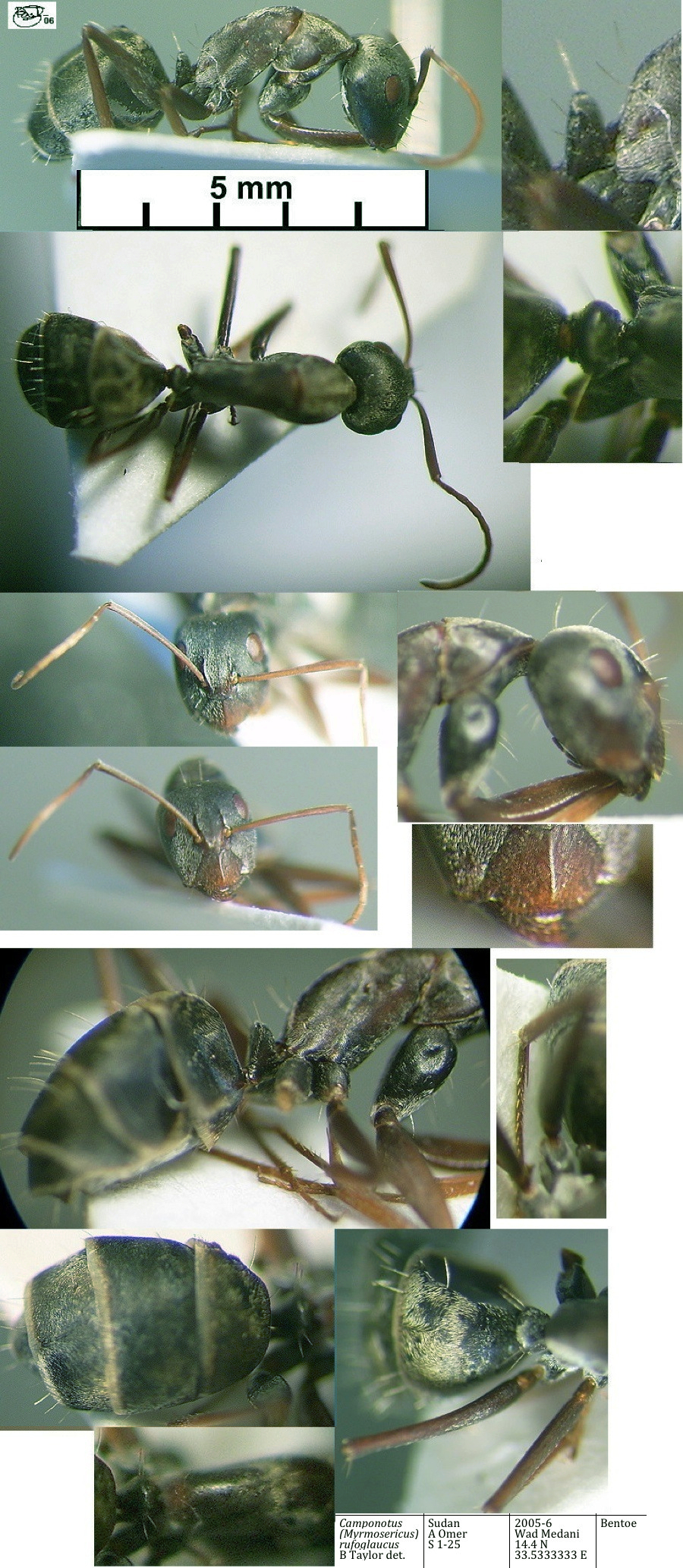 The photomontage
is of a media worker, appearing to
match the type form, from Sudan, Khartoum, collector Awatif
Omer (Sudan 25). The photomontage
is of a media worker, appearing to
match the type form, from Sudan, Khartoum, collector Awatif
Omer (Sudan 25).
|
 The photomontage
is of a minor specimen from Sudan,
Khartoum, collector Awatif Omer, 2006, Sudan 25. The photomontage
is of a minor specimen from Sudan,
Khartoum, collector Awatif Omer, 2006, Sudan 25.
|
 The photomontage
is of a minor specimen from Sudan,
Khartoum, collector Awatif Omer, 2006, Sudan 25. The photomontage
is of a minor specimen from Sudan,
Khartoum, collector Awatif Omer, 2006, Sudan 25.
|
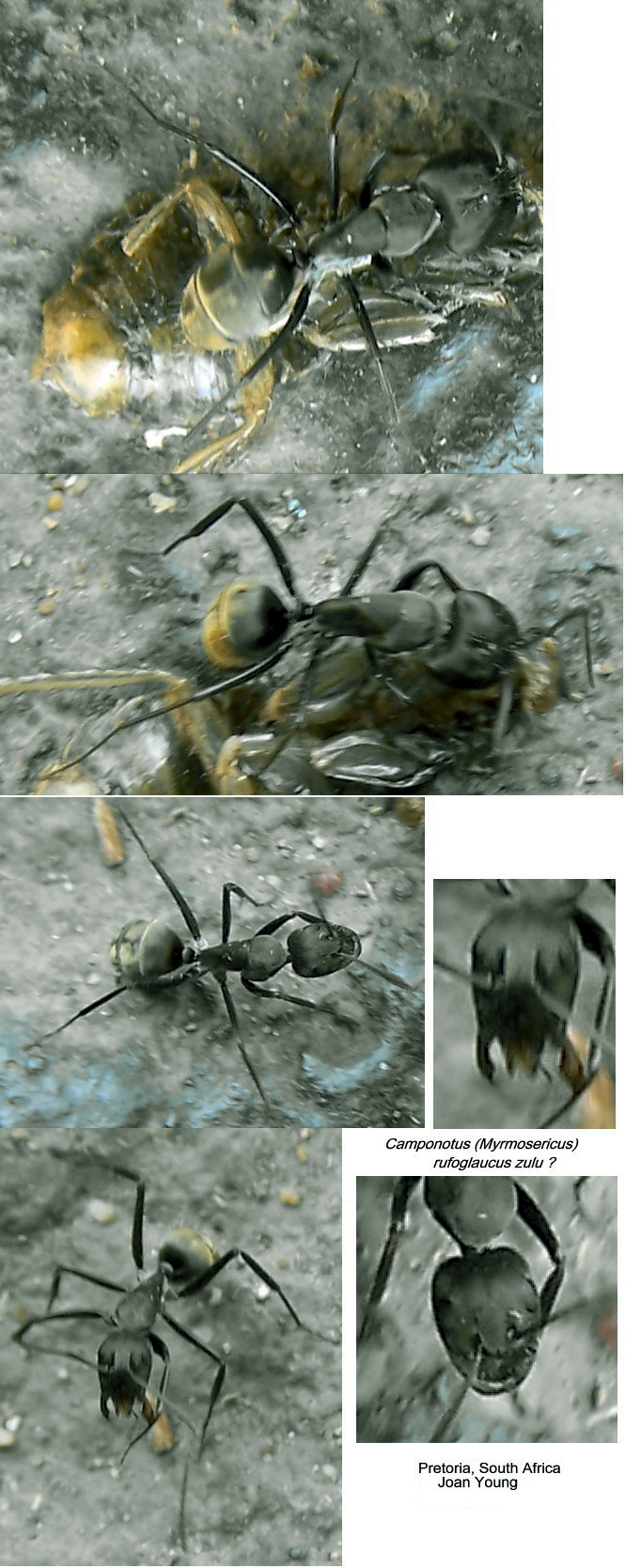 The
specimens in these field photographs were taken in Pretoria, South
Africa, by Joan Young; nos 100-9861, 100-9862 and 101-1069 The
specimens in these field photographs were taken in Pretoria, South
Africa, by Joan Young; nos 100-9861, 100-9862 and 101-1069
|
African light forms
- see also chaboti at
(major) http://www.antweb.org/specimenImages.do?code=casent0911776
and (minor) at http://www.antweb.org/specimenImages.do?code=casent0911777
|
 The
photomontage is of miniata workers collated
from http://www.antweb.org/specimen.do?name=casent0903508 The
photomontage is of miniata workers collated
from http://www.antweb.org/specimen.do?name=casent0903508
|
 The
photomontage of
a major worker of vertex is collated from http://www.antweb.org/specimen.do?name=casent0911761. The
photomontage of
a major worker of vertex is collated from http://www.antweb.org/specimen.do?name=casent0911761.
|
 The
photomontage of
a minor worker of vertex is collated from http://www.antweb.org/specimen.do?name=casent0911762. The
photomontage of
a minor worker of vertex is collated from http://www.antweb.org/specimen.do?name=casent0911762.
|
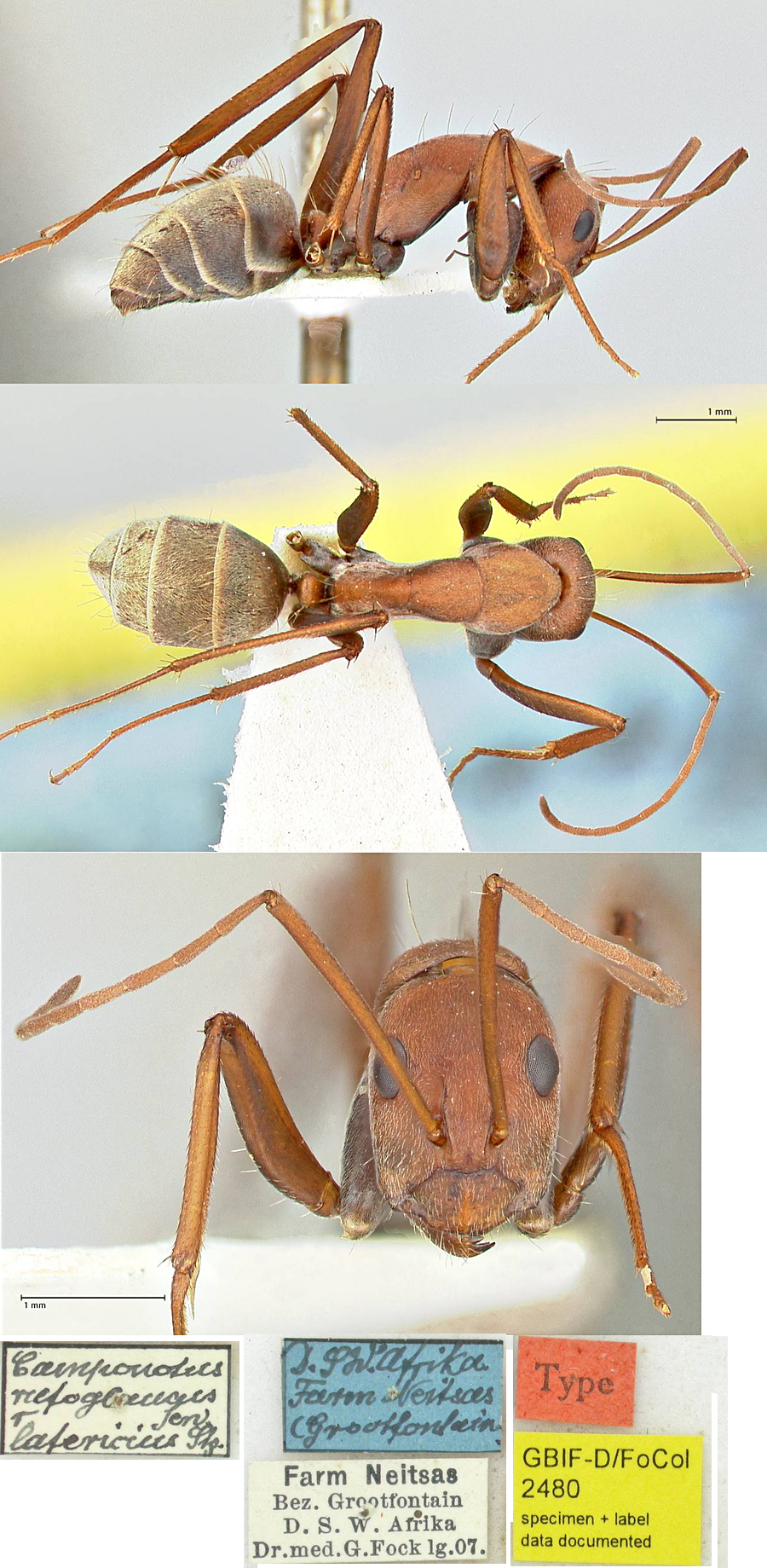 The
photomontage of
a minor worker of latericius is collated from http://www.antweb.org/specimen.do?name=focol2480. The
photomontage of
a minor worker of latericius is collated from http://www.antweb.org/specimen.do?name=focol2480.
|
 Wheeler's description of Camponotus (Myrmosericus)
rufoglaucus subspecies syphax, new subspecies is - Wheeler's description of Camponotus (Myrmosericus)
rufoglaucus subspecies syphax, new subspecies is -
MINOR WORKER - very similar to the subspecies zulu Emery from
Natal and quite as large, the largest specimens measuring fully 9 mm,
but not more slender than other forms of the species. The scapes and
tibiae are distinctly compressed, the former as in C. eugeniae
Forel, but not so broad. Propodeum evenly arcuate in profile, without
distinct base and declivity. Pubescence dull yellowish, not very long,
slightly golden on the gaster of large individuals, only feebly
converging at the mid-dorsal line on the posterior portions of the
second and third segments. Color brownish black, the legs a little
paler, the funiculi, cheeks, clypeus, mandibles, and tarsi castaneous.
Gastric segments with very narrow, dull-yellowish posterior margins.
The photomontage is of a cotype of Camponotus
rufoglaucus syphax from Zaïre. The original photographs,
together with enlarged images, are from the MCZ, Harvard University,
website at - MCZ link.
|
 The photomontage is of a cotype of Camponotus
rufoglaucus syphax from Zaïre. The original photographs,
together with enlarged images, are from the Smithsonian Institute
website at -http://ripley.si.edu/ent/nmnhtypedb/public/specimeninfopage.cfm?publicconsumption=1&typespecimenID=651. The photomontage is of a cotype of Camponotus
rufoglaucus syphax from Zaïre. The original photographs,
together with enlarged images, are from the Smithsonian Institute
website at -http://ripley.si.edu/ent/nmnhtypedb/public/specimeninfopage.cfm?publicconsumption=1&typespecimenID=651.
|
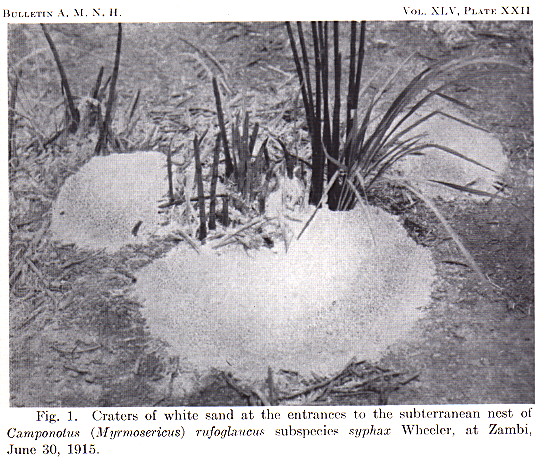 On syphax, Wheeler (1922) wrote: "Numerous
specimens from Zambi (type locality) and Boma (Lang, Chapin, and J.
Bequaert). The Zambi specimens are from three colonies, two of which
bear the following notes - "Ants forming numerous small craters in the
white sand (PI. XXII, fig. 1, right below). Only a few individuals were
seen outside the nest before noon. The nest extended to a depth of 50
cm below the surface." "Nest in the rotten base of a Hyphaene.
No larvae nor pupae could be seen, though there were certainly as many
as 1000 workers in the colony. The nest was loosely arranged in the
soft, decomposing mass." Bequaert says of the specimens from Boma that
they "run very swiftly and were nesting in the road." Workers of this
ant were sent to Prof. Emery, who compared them with his cotypes of the
subspecies zulu. He pronounced them to belong to a new
subspecies "with the pubescence on the gaster much more parallel and
less sinuous." On syphax, Wheeler (1922) wrote: "Numerous
specimens from Zambi (type locality) and Boma (Lang, Chapin, and J.
Bequaert). The Zambi specimens are from three colonies, two of which
bear the following notes - "Ants forming numerous small craters in the
white sand (PI. XXII, fig. 1, right below). Only a few individuals were
seen outside the nest before noon. The nest extended to a depth of 50
cm below the surface." "Nest in the rotten base of a Hyphaene.
No larvae nor pupae could be seen, though there were certainly as many
as 1000 workers in the colony. The nest was loosely arranged in the
soft, decomposing mass." Bequaert says of the specimens from Boma that
they "run very swiftly and were nesting in the road." Workers of this
ant were sent to Prof. Emery, who compared them with his cotypes of the
subspecies zulu. He pronounced them to belong to a new
subspecies "with the pubescence on the gaster much more parallel and
less sinuous."
|
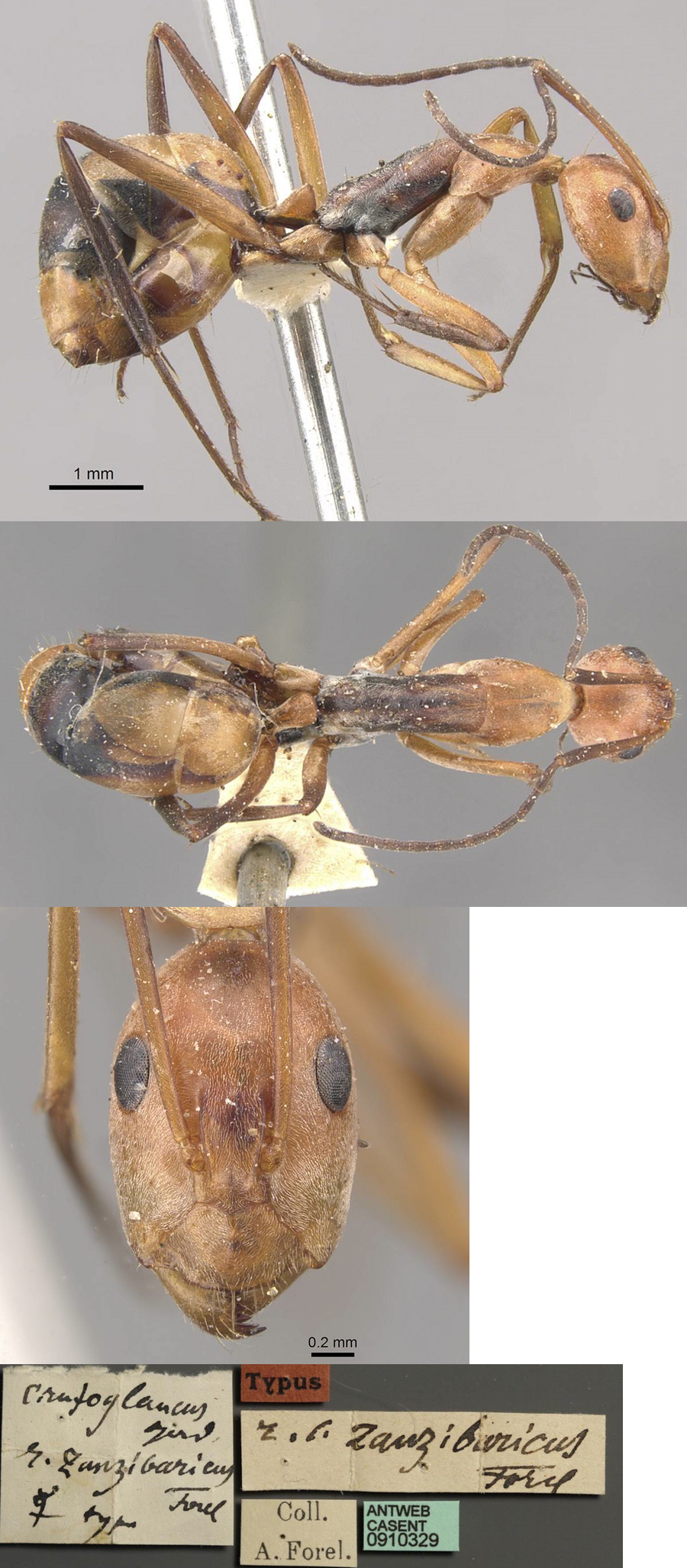 The
photomontage is of the zanzibaricus type (minor) worker
collated
from http://www.antweb.org/specimen.do?name=casent0910329. The
photomontage is of the zanzibaricus type (minor) worker
collated
from http://www.antweb.org/specimen.do?name=casent0910329.
Quite clearly this is not a rufoglaucus
form, with a very different alitrunk profile, different petiole scale
and a head shape, and, a totally different colour pattern.
|
|